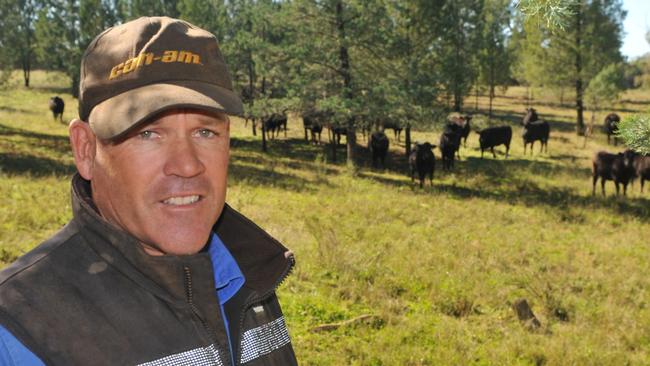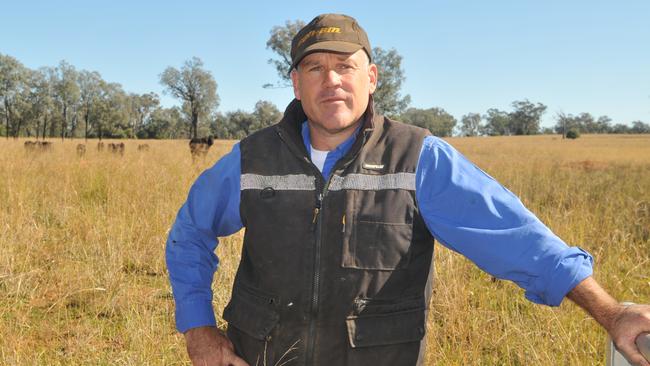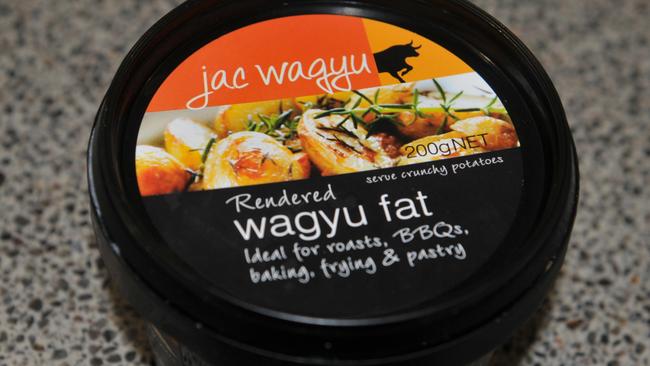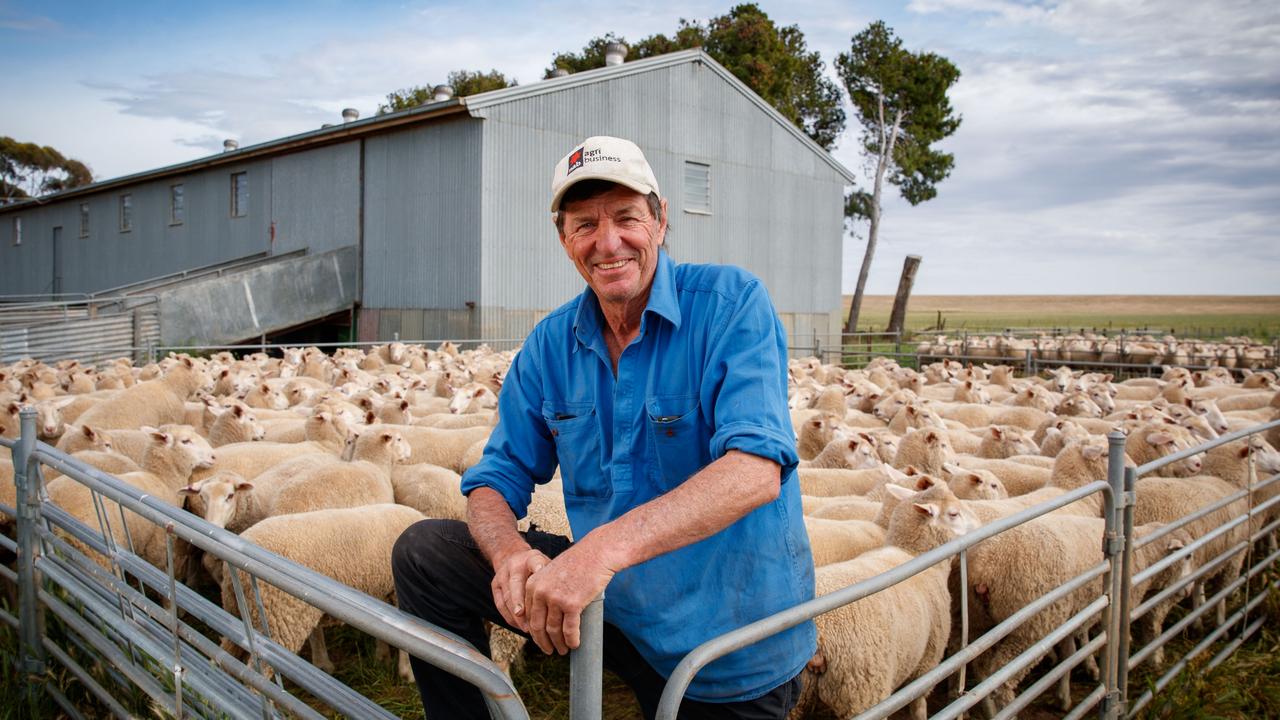Jac Wagyu: Jason Lewis of Bingara in NSW raises the marble bar
WHEN the steaks are high, the Lewis family moves in for the kill, writes JAMES WAGSTAFF.

AN AMBITIOUS plan to more than double production and diversify would normally test the nerves of even the most optimistic of farmers.
Not so much, it seems, for Wagyu producer Jason Lewis.
“Like most people in our industry, we’ve got a waiting list of customers,” says Jason, who turns off 50 Wagyu a month, to burgeoning domestic and global demand, from his fourth-generation family farm in the fertile Gwydir Valley of northern NSW.
“In a perfect world, we’d like to get to 100 (in the short-term).
“And that is (just to supply) existing customers.
“In the longer term we would like to be turning off 2000 a year and diversify our customer base more.
“That’s the bigger picture.”
Jason and wife Ann, their daughters, Alex, Taylor and Lottie, and Jason’s parents John and Lynne, run the Jac Wagyu business from their 2500ha on the banks of the Gwydir River north of Bingara.
In the space of just 15 years the business has gone from zero to hero, from embryos implanted in Angus cattle because “you couldn’t even buy Wagyu animals at the time” to a point where it now sends a container of branded beef to China a month and is the sole supplier of premium Wagyu cuts to Coles.
If that’s not enough of a rap, in 2015 Jac Wagyu was named by Meat Standards Australia as one of the top three herds in NSW for eating quality.
“We’ve come a long way,” says Jason, who studied business and marketing at university and worked off farm before returning home in 2002.
MARBLE BAR
JASON said that when he returned to farming he saw Wagyu — then a relatively minor breed in Australia — as a way of increasing profits.
“We knew of them, obviously, and having a business and marketing background, I was looking for opportunities to potentially value add,” he said.
“I didn’t really want to go down the path of value adding just anything, Wagyu provided the opportunity to do it properly, and differently, because at the time the market was developing. There wasn’t a lot of money to be made from regular beef, so we thought ‘it’s worth a try’.”
Jason said their first Wagyu were the result of embryo transfer work.
The Jac Wagyu herd now comprises about 80 purebred Wagyu cows and heifers, and 400-500 Angus cows, which form the basis of the F1 (Wagyu-Angus cross), F2 (75 per cent or higher Wagyu content) and F3 (87 per cent or higher Wagyu content) animals.
Of the 50 Wagyu processed for its brand a month, only about 20 per cent are purebreds.
Whereas once the majority of full-blood steers would be processed under the brand, now most are retained as bulls for breeding or to sell to other herds.
Most, if not all, of the females are going back into the herd in an effort to increase numbers.

SPRING FEVER
THE Lewis family farm rises from Gwydir River flats to low hilltops and receives about 710mm of rain a year.
This year, Jason said, the season has been fairly kind. “It wasn’t a really good summer but it was a cracking autumn and it was warm enough for everything to grow,” he said.
Most pastures are subtropical grasses, with lucerne, natural clovers — “which are very seasonal” — and oats (the mainstay during winter).
The Jac Wagyu herd is based on the high marbling Tajima lines Itoshigenami — “the flavour of the month” — and Michifuku.
Conscious that “it doesn’t matter how good your sire is, if you don’t have the right females you’re not going to produce the product the customer wants” Jason’s Angus bloodlines include Booroomooka, Rennylea, Te Mania and Eaglehawk.
Bulls and females are mated naturally for a spring calving, at a rate of about two bulls to a mob of 80-120 cows. Jason said that in the early days, when he only had a few Wagyu bulls, he joined one young sire with a mob of 120 heifers and he produced 112 calves.
The herd traditionally has a high pregnancy rate of 95 per cent-plus with a weaning rate of 92-95 per cent. The calves remain in the paddock, which are about 40ha, until they enter the feeding program weighing at least 350kg.
“We try and make sure they are not heavier than that 450kg entering because they do need time on grain to marble through those secondary cuts,” Jason said.
FEEDING FRENZY
THE Jac feeding set-up covers nine small paddocks, which are well sheltered and have some ground cover that the cattle “munch on but don’t flog”.
The cattle each receive about 10kg of feed per day in self feeders. Jason said barley was the main component of an otherwise secret mix.
“What you feed a Wagyu can influence its flavour,” he said. “We use barley which differentiates us from most feedlots because they are usually using a mixture of wheat and various products.
“We are on the doorstep of one of the biggest barley-growing regions in the southern hemisphere. It is a little bit more expensive than wheat, but it offers us other benefits.”
Jason said the cattle were on feed for at least a year, and up to 400 days, before being slaughtered and packed to specification at the Northern Co-operative Meat Company at Casino.
Jason said finished steers usually dressed out at about 420-450kg carcass weight. He aims for an average 410kg carcass, across the herd, including the females, with marble scores of “6 or better” out of a possible 12.
The Lewis family got into branding their own product early on “because there wasn’t a market for our females”. They now offer a number of brands, including the “top of the line” Jac Wagyu Pure, which boasts a minimum 97 per cent of Wagyu and marble score of at least 7, and the Jac Wagyu Gold label which is for the F1 Wagyu-Angus product.

SHIP SHAPE
TWO thirds of the Jac Wagyu product slaughtered each month — representing about half the value — is shipped to China.
Most prime cuts remain in Australia, where customers include Coles, which sells Jac Wagyu in selected Sydney stores including Balgowlah, Bondi, Broadway and Zetland.
“They only take a few cuts,” Jason said.
“It might be half the value of the animal, but it’s only about a third of the volume.”
Coles also stocks the value-added Jac Wagyu rendered fat, an alternative to oil or butter for roasting vegetables.
Looking to the future, Jason, who makes up to $100/kg wholesale for some of his top Wagyu cuts, said the Wagyu market was “overheated”.
While it is not expected to crash, he believes it will “come down to a more sustainable level” of $5-$6/kg liveweight.
“There is still good money to be made out of that,” he said.
“We’ve pretty much been turning back customers for four or five years.
“Being a family business, limited cash flow makes it hard to grow at the pace that is required.
“One Wagyu will owe you about $3000-$4000 depending on the cost of it going into the feeding program.
“Returns on farm have probably doubled in the past three years but meat prices have not.”


